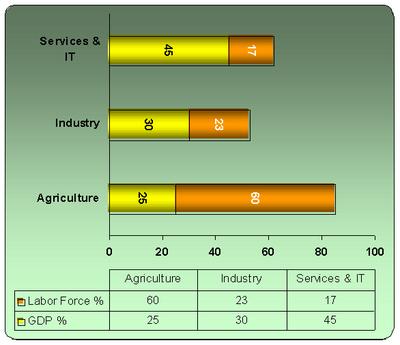India's foreign reserve is around $131 (as of Jan-1 2005) billion dollars. However, what is disturbing is our GDP and Labor force distribution. 
GDP1 (Gross Domestic Product) Distribution.
- 25% is from Agriculture
- 30% is from Industry (of which 19% is manufacturing)
- 45% is from Services & Information Technology
Labor Force: 470 million
Labor Force Distribution
- 60% Agriculture
- 23% Industry
- 17% Services & Information Technology
The decline in the contribution of agriculture towards GDP for the past two decades is in sync with the growth pattern of any developing country. The share of agriculture in the GDP has shrunk to 25% in 2004 from 40% two decades ago. However, the labor force reduction was only 10%, i.e., from 70% two decades ago to 60%.
2004 | 2020 | 2004 | 2004 | |||||
GDP | Labor | GDP | Labor | GDP | Labor | GDP | Labor | |
Agriculture | 25% | 60% | 10% | 15% | 14.8% | 50% | 1.4% | 2.4% |
Industry | 30% | 23% | 35% | 35% | 52.9% | 22% | 26.2% | 24% |
Services & Others | 45% | 17% | 55% | 55% | 32.3% | 28% | 72.5% | 73% |
Labor Force | 470 Million | 700 Million | 778.1 Million | 146.5 Million | ||||
Public Debt2 | 59.7 % of GDP | 30.1 % of GDP | 62.4% of GDP | |||||
Exports | $57 Billion | $436 Billion | $714 Billion | |||||
Imports | $74 Billion | $397 Billion | $1.26 Trillion | |||||
GDP per Capita3 | $2900.00 | $5000.00 | $37,800.00 | |||||
PPP4 | $3.033 Trillion | $6.449 Trillion | $10.99 Trillion | |||||
GDP Real Growth Rate5 | 8.3% | 9.1% | 3.1% | |||||
The transformation in the GDP is typical of developing country experience. However, if you look at the labor force distribution, we find that 75% of the GDP contribution comes from 40% of the labor force.
All successful developing economies moved significant numbers of people out of agriculture as the share of agriculture in the GDP declined. The developed nations' GDP (see US) shows this fact.
So, over here, 60% of (Labor force) our population is dependent on Agriculture, and imagine the chaos it will create when there is monsoon failure. Another misconception is that while
We (
The question over here is –
WHAT CAN WE (The people of
1. GDP – Gross Domestic Product is the value of all final goods and services produced within a nation in a given year.
2. Public Debt – All government borrowings minus repayments denominated in a country's home currency. It should not be confused with external debt, which reflects the foreign currency liabilities of private and public sectors and must be financed out of foreign exchange earnings.
3. GDP Per Capita - GDP on a purchasing power parity basis divided by population.
4. PPP – Purchasing Power Parity (2004 estimate).




No comments:
Post a Comment